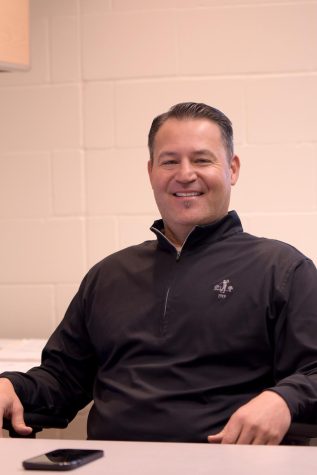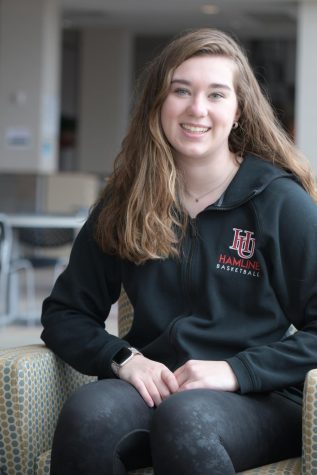Name Image and Likelihood
Conversations in powerhouse Division I schools have trickled down to Hamline and other Division III universities regarding what could be considered the new lucrative element of collegiate sports.
March 30, 2022

views the world of NIL as untapped
potential for student athletes at Hamline and is doing his best to stay ahead of the curve. (Aidan Stromdahl)
Doug Edert is the sixth man on the Saint Peter’s University men’s basketball team, a small Division I program from Jersey City, New Jersey. Days before his 15 seeded Peacocks faced off against the 2 seeded college basketball powerhouse Kentucky Wildcats in the NCAA March Madness tournament, he decided to grow out his mustache. His teammates did not appreciate the mustache in the beginning, but that didn’t seem to bother Edert.
In the Peacocks’ first game, he came off the bench, dropped 20 points shooting 71 percent from the field and helped his Peacocks upset the Wildcats. The next game Edert rose to the occasion once again scoring 13 points off the bench helping his team beat Murray State, a team that had only lost two games to that point.
Edert’s mustache has been solidified in the March Madness folklore forever and he knows it. The best part is that thanks to the new NCAA rules regarding Name Image and Likeness, Doug Edert can profit off of his mustache and Saint Peters magical run into the sweet sixteen.
Name Image and Likeness, commonly referred to as NIL, can be described as a collegiate athlete’s ability to make money and profit off of their status as an athlete. All the athletes of the past who have been fined or declared ineligible due to violating this rule may be upset with this change, but the collegiate athletes now and ones of the future will have to navigate through this new era of college sports.
It may seem like this rule will only impact higher level Division I athletes, but Hamline’s Athletic Director Jason Verdugo has to be sure he is ahead of the curve regarding NIL.

the women’s basketball team
believes that she would participate
in the NIL effort if it “benefitted
the athletic department at
Hamline.” (Aidan Stromdahl)
“I think all the athletic directors at the Division III level are still trying to figure out if this is going to be a touch point for us,” Verdugo said. No one knows how this is going to affect Division III athletes in the coming years mainly because no one even knows how it will affect Division I athletes.
Some college athletes with large social media followings have started to garner more attention and grow their bank accounts through this rule. Olivia Dunne, a Louisiana State University gymnast with a TikTok following of over 5 million followers has already signed her first NIL deal with an activewear brand Vuori. This is an extreme example as Dunne is one of the most popular personalities on the app, but it is not impossible it will become more common in the future.
When talking about being active in the field of NIL, Ally Thompson, a forward on the Hamline Women’s Basketball team said “I feel like it would be something I would do if it benefited the athletic department here at Hamline.”
Smaller schools like Hamline are not too concerned about NIL at the moment mainly because major audiences would rather watch the March Madness tournament or the College Football playoffs. But that is not to say athletes would not take advantage of the opportunity if it arises.

plays soccer at Hamline and sees
many benefits to engaging with
NIL at the Division III level. (Aidan Stromdahl)
“It is an opportunity for me to make some extra money and to spread Hamline’s image and attract other student athletes,” said Men’s Soccer player and Student Athlete Advisory Committee (SAAC) member Luke Rimington. Both Rimington and Thompson know the benefits that NIL can provide to smaller institutions like Hamline.
There aren’t going to be any record breaking contracts signed any time soon, but every college student, whether they are an athlete or not, is always looking for that extra bit of cash. Whether or not athletes at Hamline University ever get paid for their time as an athlete, that shouldn’t matter.
“They’re missing out, in my opinion,” said Verdugo when discussing students’ decisions to play collegiate sports at any level. Student athletes at smaller universities have only one thing motivating them when choosing to play a college sport. It’s not to sign an NIL deal, not to gain a large social media following, or get recognized as a folk hero in the month of March. It is to play the game they love and enjoy every second of it.
